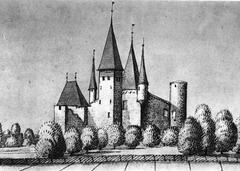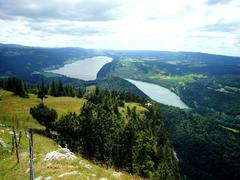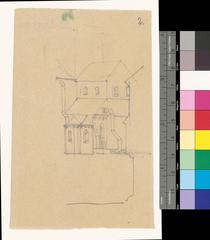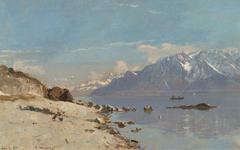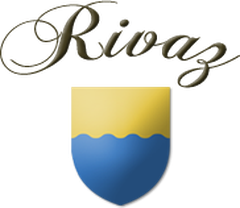
Metro Lausanne–Ouchy: Visiting Hours, Tickets, and Travel Guide
Date: 04/07/2025
Introduction
The Métro Lausanne–Ouchy is both a symbol of Lausanne’s forward-thinking urban planning and a practical, scenic way to explore the city. Originating as Switzerland’s first public funicular in 1877, it has evolved into the technologically advanced, fully automated M2 metro line that now links the lakeside at Ouchy with Lausanne’s city center and northern neighborhoods. This guide provides detailed, up-to-date information on its historical significance, visiting hours, ticket options, accessibility, and key attractions accessible via the M2, ensuring you have all the essentials for a memorable trip to Lausanne.
Official visitor resources and the latest schedules can be found at the Transports Publics Lausannois (TL) and Lausanne Tourisme.
Table of Contents
- Historical Overview
- Visiting Hours and Ticket Information
- Accessibility and Station Facilities
- Nearby Attractions and Travel Tips
- Frequently Asked Questions (FAQ)
- Lausanne Cathedral: Practical Visitor Guide
- Summary of Key Points
- References and Further Reading
Historical Overview
The Funicular Era (1877–1958)
Lausanne’s steep topography called for innovative transport solutions, leading to the creation of “La Ficelle” in 1877—the country’s first public funicular. The line overcame a 100-meter elevation between Ouchy on Lake Geneva and the city center at Flon, using a water-balance system to move cars up and down. This pioneering railway quickly became a beloved part of Lausanne’s urban landscape (Wikipedia: Métro Lausanne–Ouchy, notrehistoire.ch).
Rack Railway and Modernization (1958–2006)
In 1958, the original funicular was replaced by a rack-and-pinion railway (Strub system) to meet growing demand and improve safety. The line was upgraded with new stations at Jordils and Montriond, increasing its capacity and integration into Lausanne’s expanding transit network (Wikipedia: Métro Lausanne–Ouchy). Despite modernization, locals continued to refer to it as “La Ficelle,” and it remained central to city life.
Transition to Metro and the M2 Line (2006–Present)
By the early 2000s, further upgrades were necessary. The historic rack railway closed in 2006, making way for construction of the fully automated M2 metro—the country’s first driverless underground line. The new M2 opened in 2008, running a 5.9 km route from Ouchy-Olympique to Croisettes, with 14 stations and a vertical climb of 300 meters (myswitzerland.com, Wikipedia: Lausanne Métro, mapa-metro.com).
The M2’s rubber-tyred, driverless technology, modeled after Paris Métro Line 14, enables rapid, frequent service even on steep slopes. Lausanne, with its relatively small population, became the world’s smallest city to operate a full metro system (Wikipedia: Lausanne Métro).
Expansion and Future Developments
- 2008: M2 line opens, extending service north to Épalinges.
- 2014: Plans for the M3 line are approved via public referendum.
- 2022: The Swiss government greenlights a double-track tunnel and M3 construction, further enhancing city connectivity (axes-forts.ch).
The upcoming M3 will use similar automation and will share tracks with the M2 between Ouchy and Lausanne-Gare (Wikipedia: Lausanne Métro).
Visiting Hours and Ticket Information
Metro Operating Hours
- Daily: Approximately 5:00 AM to midnight
- Frequency: Every 3–7 minutes during peak hours, slightly less at night
For precise times, check the TL website or their mobile app.
Ticket Options and Prices
- Single Ticket: Valid for one journey within Lausanne’s main zones; from CHF 3.00
- Day Pass: Unlimited travel on TL buses and metros for a full day—ideal for tourists
- Multi-Trip Cards: Discounted rates for multiple journeys
- Lausanne Transport Card: Free for hotel guests; includes unlimited city transport and discounts on attractions (lausanne-tourisme.ch)
- Purchase Points: Ticket machines at stations, online, or via the TL app; cashless options available
Remember to validate your ticket before boarding.
Accessibility and Station Facilities
The M2 is designed for universal access:
- Elevators and Ramps: Available at all stations for wheelchairs, strollers, and luggage (MySwitzerland)
- Tactile Floors: For visually impaired travelers
- Real-Time Info Screens: Display departures and service updates
- Multilingual Signage: French, English, and German
- Facilities: Major stations like Ouchy-Olympique, Flon, and Lausanne-Gare have restrooms, seating, and nearby cafés (MySwitzerland)
Nearby Attractions and Travel Tips
Top Sites Accessible via Metro
- Ouchy-Olympique: Lake Geneva promenade, Château d’Ouchy, Olympic Museum, rose gardens, and boat cruises (Touring Switzerland)
- Lausanne-Gare: Mainline rail hub
- Flon: Urban center with shops, dining, nightlife, and events
- Riponne–Maurice Béjart: Gateway to the Old Town and Lausanne Cathedral
Activities and Experiences
- Promenade de la Ficelle: Scenic walking route above the metro, echoing the old funicular’s path (Lausanne Tourisme)
- Station Soundscapes: Listen for local sounds at each stop—seagulls at Ouchy, train whistles at Lausanne-Gare, and more
Travel Tips
- Best Times: Early morning or late evening for fewer crowds and great lake views
- Luggage and Bikes: Elevators and ramps at all stations; bikes allowed outside rush hours and must be ticketed. Folding bikes permitted anytime if folded
- Pets: Small pets in carriers travel free; larger dogs require a half-price ticket
- Safety: Clean, secure, and equipped with surveillance; eating/drinking discouraged on board
Frequently Asked Questions (FAQ)
Q: What are the Métro Lausanne–Ouchy operating hours?
A: Daily from about 5:00 AM to midnight, with frequent trains throughout the day.
Q: Where can I buy tickets?
A: At station machines, online, or via the TL app. The Lausanne Transport Card is provided free to hotel guests.
Q: Is the metro accessible for people with disabilities?
A: Yes, all stations have elevators, ramps, and barrier-free entry.
Q: Can I bring my bike?
A: Bicycles are allowed outside rush hours with a ticket. Folding bikes are permitted at all times if folded.
Q: What historical sites are accessible via metro?
A: Ouchy promenade, Château d’Ouchy, Lausanne Cathedral, Flon district, and the Olympic Museum.
Q: Are there regular guided tours?
A: The metro itself doesn’t offer tours, but the tourist office organizes city tours that often include metro history.
Lausanne Cathedral: Practical Visitor Guide
Overview
Lausanne Cathedral (Cathédrale de Lausanne) is one of Switzerland’s finest examples of Gothic architecture and a short walk from Riponne–Maurice Béjart station. Built between the 12th and 13th centuries, it features exquisite stained glass, a famous organ, and panoramic views from its tower (lausanne-tourisme.ch).
Opening Hours
- April–October: Daily, 10:00–18:00
- November–March: Daily, 10:00–17:00
- Religious Services: Visitors welcome outside service times
Admission
- Cathedral: Free entry (donations welcome)
- Tower access: CHF 6 (adults), CHF 3 (children/seniors); tickets on-site or online
Accessibility and Getting There
- By Metro: M2 to Flon, then 10-minute uphill walk
- By Bus: Several city bus lines stop nearby
- Facilities: Ramps and elevators at the main entrance
Highlights
- Stained Glass: 13th-century windows, including the Rose Window
- Organ: One of Switzerland’s largest, with regular concerts
- Tower: Panoramic city and lake views
- Guided Tours: Available by booking; audio guides offered
Tips
- Visit early/late for quiet and best photos
- Photography is allowed, but no flash
- Dress modestly, especially during services
Nearby
- Place de la Palud: Historic square with animated clock and cafés
- Olympic Museum: Accessible via M2 and a short walk
- Dining: Swiss and international restaurants around the Old Town
For more, see Lausanne Old Town, Olympic Museum, and Swiss Gothic Architecture.
Summary of Key Points
The Métro Lausanne–Ouchy embodies Lausanne’s blend of tradition and innovation, offering visitors reliable, accessible, and scenic transport through the city’s most important districts. Daily service from early morning to midnight, flexible ticket options—including the free Lausanne Transport Card for hotel guests—and barrier-free stations make it an ideal choice for exploring Lausanne’s historical and cultural sites. With ongoing expansions like the M3 line, the metro continues to shape the city’s future while honoring its unique past. Plan your trip with official resources and enjoy everything Lausanne has to offer.
References and Further Reading
- Métro Lausanne–Ouchy, Wikipedia
- Lausanne Métro, Wikipedia
- Métro Lausanne–Ouchy Historical Gallery, NotreHistoire.ch
- Metro Lausanne Facts, MySwitzerland.com
- Lausanne Transport Official Website (TL)
- Lausanne Tourism Official Site
- Lausanne Public Transport Information, VD.ch
- RTS News on Lausanne Metro
- Switzerland is Yours: Lausanne Transport
- Touring Switzerland: Ouchy
Ready to discover Lausanne? Download the official TL app for real-time schedules and tickets. For personalized travel tips, visit the Lausanne Tourist Office or explore related guides on Swiss urban travel.



